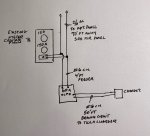Peter Furrow
We’re not born humble, we’re born to be humbled
- Location
- Cape canaveral Fl
- Occupation
- Electrical contractor
A question came up regarding an installation and “tap rules”
article 240.21 B(2).
The apartment owner on the third floor wanted a Tesla charger. Polaris taps would be installed at the meter center after the 150 A main for the apartment. The number six copper feeder wire would be tapped off of the 2\0 Al going to the 3rd floor apt. That tesla feeder is only 4 feet so It wouldn’t be a violation. It transitions to a branch circuit and goes 50 feet to the charger and still will not be a violation. Correct?
However, Now that the feeder has been tapped for the third-floor indoor apartment panel and it’s 70 feet away this would violate the 25 foot tap rule. Correct?
My thought is that the violation is not so much the Tesla charger tap but the third-floor indoor panel has now become a tap and it’s over 70 feet
article 240.21 B(2).
The apartment owner on the third floor wanted a Tesla charger. Polaris taps would be installed at the meter center after the 150 A main for the apartment. The number six copper feeder wire would be tapped off of the 2\0 Al going to the 3rd floor apt. That tesla feeder is only 4 feet so It wouldn’t be a violation. It transitions to a branch circuit and goes 50 feet to the charger and still will not be a violation. Correct?
However, Now that the feeder has been tapped for the third-floor indoor apartment panel and it’s 70 feet away this would violate the 25 foot tap rule. Correct?
My thought is that the violation is not so much the Tesla charger tap but the third-floor indoor panel has now become a tap and it’s over 70 feet



